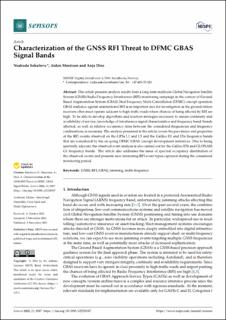| dc.contributor.author | Sokolova, Nadezda | |
| dc.contributor.author | Morrison, Aiden J | |
| dc.contributor.author | Diez, Anja | |
| dc.date.accessioned | 2023-03-02T15:12:38Z | |
| dc.date.available | 2023-03-02T15:12:38Z | |
| dc.date.created | 2022-11-08T10:03:49Z | |
| dc.date.issued | 2022 | |
| dc.identifier.citation | Sensors. 2022, 22 (22), 8587. | en_US |
| dc.identifier.issn | 1424-8220 | |
| dc.identifier.uri | https://hdl.handle.net/11250/3055513 | |
| dc.description.abstract | This article presents analysis results from a long-term multi-site Global Navigation Satellite System (GNSS) Radio Frequency Interference (RFI) monitoring campaign in the context of Ground Based Augmentation System (GBAS) Dual Frequency Multi Constellation (DFMC) concept operation. GBAS resilience against unintentional RFI is an important area for investigation as the ground station receivers often must operate adjacent to high-traffic roads where chances of being affected by RFI are high. To be able to develop algorithms and reaction strategies necessary to ensure continuity and availability of service, knowledge of interference signal characteristics and frequency band/bands affected, as well as relative occurrence rates between the considered frequencies and frequency combinations, is necessary. The analysis presented in the article covers the prevalence and properties of the RFI events observed on the GPS L1 and L5 and the Galileo E1 and E5a frequency bands that are considered by the on-going DFMC GBAS concept development initiatives. Due to being spectrally adjacent, the observed event analysis is also carried out for the Galileo E5b and GLONASS G1 frequency bands. The article also addresses the issue of spectral occupancy distribution of the observed events and presents new interesting RFI event types captured during the considered monitoring period. | en_US |
| dc.language.iso | eng | en_US |
| dc.publisher | MDPI | en_US |
| dc.rights | Navngivelse 4.0 Internasjonal | * |
| dc.rights.uri | http://creativecommons.org/licenses/by/4.0/deed.no | * |
| dc.title | Characterization of the GNSS RFI Threat to DFMC GBAS Signal Bands | en_US |
| dc.type | Peer reviewed | en_US |
| dc.type | Journal article | en_US |
| dc.description.version | publishedVersion | en_US |
| dc.rights.holder | © 2022 by the authors. | en_US |
| dc.source.volume | 22 | en_US |
| dc.source.journal | Sensors | en_US |
| dc.source.issue | 22 | en_US |
| dc.identifier.doi | 10.3390/s22228587 | |
| dc.identifier.cristin | 2070398 | |
| dc.relation.project | Norges forskningsråd: 288634 | en_US |
| dc.source.articlenumber | 8587 | en_US |
| cristin.ispublished | true | |
| cristin.fulltext | postprint | |
| cristin.qualitycode | 1 | |

